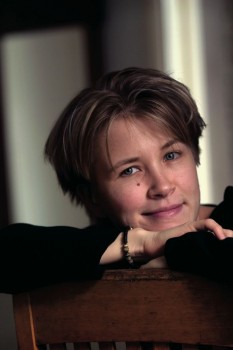Movies and mores
16 April 2012 | Authors, Interviews

Tuuve Aro. Photo: Liisa Takala
Interview with Tuuve Aro, author of Himokone (‘Desire machine’): in these short stories she borrows titles and ambiance from the silver screen
A dark theatre, the smell of popcorn, expectation quivering in the air. Since childhood, the author and film critic Tuuve Aro (born 1973) has loved that magic moment when a new, exciting story is about to begin once again on the silver screen.
The stories in her fourth short story collection Himokone (‘Desire machine’, WSOY, 2012) have taken their names from films – Vertigo, Alien, and Invasion of the Body Snatchers, for example. The book’s title comes from a certain Dr Samuel L. Brimstone, member of the ‘Royal Film Academy of Suffolk’: according to him, a film projector is a desire machine: it doesn’t give anything, it only shows, and for that very reason it is hard to resist.
A-L E: What kinds of frames do the films form for your stories?
TA: Mostly suggestive ones. The events in the stories don’t correspond with those in the film, but the atmosphere of the stories comes from the films. I feel that films offer an interesting frame for examining various phenomena. For instance, the film Invasion of the Body Snatchers was basically a metaphor for the spread of communism: in my story, however, the human-eating monsters are babies, from the viewpoint of a single, childless woman. Naturally, I don’t have any children…
A-L E: Your filmic stories paint a perceptive portrait of our times. They examine consumer hysteria and the absurdity of working life, and also loneliness. In Fight Club, you write about Karoliina Järvi, a young poet hungry for fame, who creates a literary career through social media long before her first collection is published.
TA: It definitely feels quite absurd that nowadays networking and building a literary career comes first – before publishing anything, you create a product of your self and your life. In this phenomenon-first culture, it’s the person or the trend that’s being sold, not the literary worthiness of a book. A writer today has to know how to sell herself, like sausage. I don’t want to accept that.
A-L E: What is your relationship as a writer to social media?
TA: In my thirteen years as a writer, I’ve been adept at avoiding the pitfalls of competition and envy. But this has been feeling more and more difficult since I joined Facebook a few years ago. Suddenly careers, successes, prizes and disappointments are all on display, and it’s easy to slip into the habit of comparison. It makes no sense. It just diverts attention from what is essential – the writing. You can see the change of mood in literary circles – a vague uneasiness, public poses, sniping. The storms in the publishing field and the general coarsening of values doesn’t help the situation.
A-L E: In your story Tappajahai (Jaws), a woman thirsty for love accidentally destroys the objects of her affection. The way the story arc takes a sudden, strange turn, the dark comedy, the highly original characters, are these signature features of your work?
TA: I like to tweak reality into new and strange configurations in my books. There’s also typically a visuality to the text. I see the events of my stories as images.
A-L E: You’ve published four collections of short stories, two novels, and one children’s book. Which genre is nearest to you?
TA: Definitely the short story. The encapsulation, building ‘short form suspense’ fascinates me. Stopping at the right time is its own skill.
A-L E: Your first film review was published in 1998, your first book, Harmia lämpöpatterista (‘Trouble with the radiator’) came out in 1999. How do fiction and criticism overlap?
TA: Quite naturally. They’re completely different styles of writing, but they feed each other. Reviewing is a deliberate, analytical act. I progress more instinctively when I’m writing fiction. Excessive deliberation in fiction can easily become dry.
A-L E: At the end of Himokone, Samuel L. Brimstone is quoted again: ‘When all is said and done and we’re pondering what life was all about, we no longer distinguish between what we have seen and what we have experienced.’ Is this also a summation of the life philosophy of a film buff author?
TA: In my own life, fact and fiction, sleeping and waking, film and life are definitely mixing together all the time. We live nowadays amid a flood of entertaining stimuli where it’s hard to distinguish between what’s true and what’s made up… This can be disorienting, even oppressive. On the other hand, without films, without my bizarre dreams, I wouldn’t be me. Movies have made me who I am.
Translated by Lola Rogers
Tags: short story
No comments for this entry yet
Leave a comment
Also by Anna-Leena Ekroos
The princess who quit - 27 February 2014
The party's not yet over - 14 November 2013
Journeys to nearby places - 18 April 2013
Fools and devils - 30 June 2007
-
About the writer
Anna-Leena Ekroos (born 1968) is a freelance journalist and critic living in Vaasa.
© Writers and translators. Anyone wishing to make use of material published on this website should apply to the Editors.
